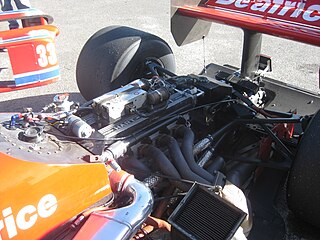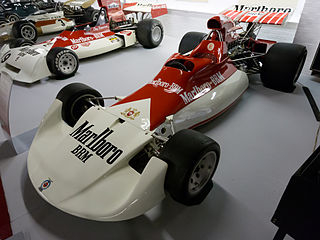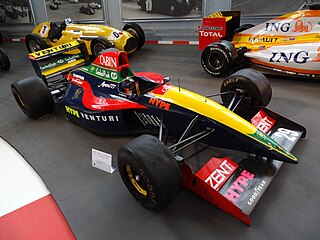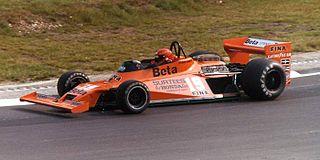Arrows Grand Prix International was a British Formula One team active from 1978 to 2002. It was known as Footwork from 1991 to 1996.

Mauro Giuseppe Baldi is an Italian former Formula One and endurance driver who raced for the Arrows, Alfa Romeo and Spirit teams.
Spirit Racing was a racing car constructor and racing team from the United Kingdom. Founded in 1981, it participated in the 1982 European Formula Two Championship, moved to Formula One in 1983, then competing in the 1988 F3000 season before finally folding at the end of that year. In 26 F1 races, its best finish was seventh at the 1983 Dutch Grand Prix.
Toleman Motorsport was a Formula One constructor based in the UK. It was active between 1981 and 1985 and participated in 70 Grands Prix.

Brian Hart Ltd., also known as Hart and Hart Racing Engines, was a motor racing engine manufacturer that participated in 157 Formula One Grands Prix, powering a total of 368 entries.

Chris Amon Racing, also known simply as Amon, was a Formula One team established by New Zealand driver Chris Amon. It competed as a privateer team in the 1966 Italian Grand Prix, then as a constructor in its own right in the 1974 Formula One season.

Modena Team SpA was a Formula One team from Italy that contested a single season in 1991. The team had a rather confused history, and is often referred to as the "Lambo" or Lamborghini team because of its connections to the Italian automotive manufacturer. It competed in 16 World Championship Grands Prix but scored no Championship points. Its best result was seventh in the 1991 United States Grand Prix.

The BRM P180 was a Formula One racing car, built by BRM and designed by Tony Southgate which raced in the 1972 Formula One season. It was powered by a BRM 3.0-litre V12 engine. One of the main features of the P180 was that the radiators had moved to the rear of the car, allowing the nose of the car to be very wide and flat. It competed in five World Championship Grands Prix, with a total of seven individual entries. The car scored no World Championship points, its best finish being eighth at the 1972 Italian Grand Prix.

The BRM P160 was a Formula One racing car designed by Tony Southgate for the British Racing Motors team, which raced in the 1971, 1972, 1973 and 1974 Formula One seasons. It was powered by a 3.0-litre V12 engine.

The Leyton House CG911 was a Formula One racing car designed by Chris Murphy and Gustav Brunner for the 1991 Formula One season. Unlike its CG901 predecessor, which used a Judd EV V8 engine, the CG911 used an Ilmor 2175A V10 engine. Leyton House Racing initially started the 1991 season with Maurício Gugelmin and Ivan Capelli as their drivers, as they had in 1990, but Karl Wendlinger replaced Capelli for the final two races of the season. For 1992, when Leyton House renamed themselves as March F1, the CG911 was updated to the March CG911B specification, with Wendlinger, Jan Lammers, Paul Belmondo and Emanuele Naspetti all sharing driving duties. Although March initially intended to run the CG911C in 1993 with Lammers and Jean-Marc Gounon, the team folded and they did not compete that year.
The Fondmetal GR02 was a Formula One racing car designed by Sergio Rinland and his Astauto studio for the 1992 Formula One season. Built to replace the Fondmetal GR01, as Fondmetal's team boss Gabriele Rumi had never been impressed by that car or its predecessor, the Fomet-1, the GR02 used the same 3.5-litre Ford HBA5 V8 engine as its predecessor. Gabriele Tarquini gave the GR02 its début at the 1992 Canadian Grand Prix, whilst team mate Andrea Chiesa first drove it in the following 1992 French Grand Prix. Although the GR02 showed promise, and drew praise from the media, Fondmetal's financial difficulties meant that they withdrew from Formula One after the 1992 Italian Grand Prix.

The Venturi LC92 was a Formula One racing car designed by Robin Herd, Michel Têtu and Tino Belli for the 1992 Formula One season. Built to replace the Lola LC91 used in the previous season, after Larrousse had ended their agreement with Lola, the LC92 used a 3.5-litre Lamborghini 3512 V12 engine. It was the first car that Larrousse had built since Venturi had bought a controlling stake in the team, with Bertrand Gachot and Ukyo Katayama being selected to drive the car. Although the LC92 finished more races than its predecessor, it was no quicker, and Gachot scored the team's only point of the season at the 1992 Monaco Grand Prix. After Venturi sold their stake in Larrousse at the end of the season, the LC92 was replaced by the Larrousse LH93, which was marginally more successful.

The Williams FW was a Formula One car used by Frank Williams Racing Cars during the 1973, 1974 and 1975 seasons. It was designed by John Clarke.

The Williams FW04 was a Formula One car used by Frank Williams Racing Cars during the 1975 season and Wolf–Williams Racing during the 1976 season. The car was a development of the Williams FW and two were built. Although not a particularly successful car, an FW04 finished second at the 1975 German Grand Prix.

The Fittipaldi FD was a series of Formula One chassis designed by Richard Divila and used by Fittipaldi Automotive in the 1975, 1976 and 1977 seasons. The initial chassis was designated Fittipaldi FD01 and there were three minor developments designated, Fittipaldi FD02, Fittipaldi FD03 and Fittipaldi FD04 respectively. FD series cars competed in 37 races making 43 individual entries in total. The chassis achieved a best finish of fourth place at both the 1977 Argentine and Brazilian Grands Prix driven on each occasion by former World Champion and joint team-owner Emerson Fittipaldi. It scored a total of 11 World Championship points.

The Surtees TS20 was a Formula One car used by Surtees during the 1978 Formula One season. It was designed by John Surtees and Ken Sears.

The Penske PC1 was a Formula One racing car developed and raced by Penske Racing during the 1974 and 1975 Formula One seasons. The car was designed by Geoff Ferris, and was raced by drivers Mark Donohue and John Watson. The PC1 entered and competed in 12 Grands Prix, and was replaced by the Penske PC3 in the 1976 season.
The Fittipaldi F6 was a Formula One car designed by Ralph Bellamy and used by Fittipaldi Automotive in the 1979 Formula One season. The engine was a Ford Cosworth DFV, and the car was driven by Brazilian Emerson Fittipaldi but achieved no points during the season. The car was modified to become the F6A, used later in 1979 and was succeeded by the Fittipaldi F7.

The Penske PC3 was a Formula One car used by Citibank Team Penske during the 1976 Formula One season, It was designed by Geoff Ferris.

The ATS HS1 was a Formula One car used by ATS during the 1978 Formula One season. It was designed by John Gentry and Robin Herd.















